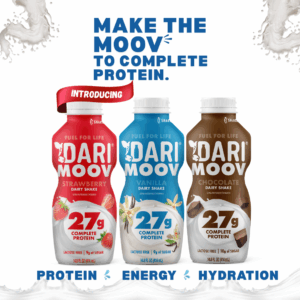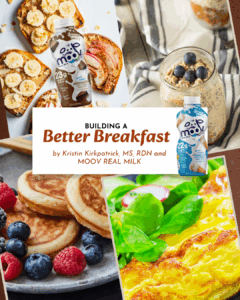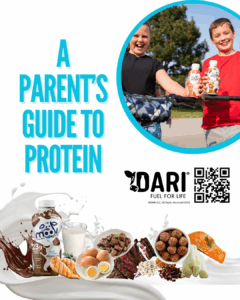TALES FROM THE
daRI® FARM
Dari LLC Announces the All NEW DARI® MOOV™: The Ultimate Ultra-Filtered, Lactose-Free Protein Shake
FOR IMMEDIATE RELEASE

Dari LLC Announces the All NEW DARI® MOOV™: The Ultimate Ultra-Filtered, Lactose-Free Protein Shake
September 22, 2025 — DARI® LLC is proud to introduce the all-new DARI® MOOV™, an innovative ultra-filtered, lactose-free whole milk protein shake designed to fuel your day with the cleanest, most powerful nutrients. Packed with 27g of protein per bottle, DARI® MOOV™ offers a deliciously smooth and natural way to support your active lifestyle, whether you’re hitting the gym, powering through a busy workday, or simply looking for a nutritious on-the-go high protein snack.
DARI® MOOV™ is the new standard in protein shakes, providing a unique blend of high-quality ingredients without compromise. Free from artificial sweeteners, flavors, and colors, this product is made from whole milk that has been ultra-filtered to deliver a clean, smooth taste with every sip. Each bottle offers a perfect balance of protein, healthy fats, and natural hydration.
“After receiving incredible feedback from our loyal customers, we’ve worked hard to create a protein shake that meets the demand for simplicity, transparency, and high-quality nutrition,” said Dan Ellsworth, CEO of Dari LLC. “DARI MOOV is the result of that effort, offering the benefits of whole milk with 27g of protein, while ensuring a clean label with no artificial additives.”
Key Features of DARI® MOOV™:
● 27g of Protein per bottle
● Ultra-filtered for a creamy-smooth texture
● Lactose-Free for digestive comfort
● No Artificial Sweeteners, Flavors, or Colors
● A Flavored Whole Milk option for superior taste and nutrition
● Available in convenient, single-serve bottles
DARI® MOOV™ is perfect for anyone seeking a clean, nutritious option to support their protein needs. Whether you are an athlete, a busy professional, or someone looking for a convenient yet wholesome snack, DARI® MOOV™ fits seamlessly into any lifestyle.
Where to Find DARI® MOOV™:
DARI® MOOV™ is available in grocery stores nationwide, prominently placed in the dairy aisle. With its clean ingredients and powerful protein boost, it’s the shake you can feel good about drinking every day.
For more information about DARI® MOOV™ and where to find it, visit www.realdari.com.
About Dari LLC:
Dari LLC is a leading innovator in dairy products, committed to providing the highest quality, sustainably sourced, and health-focused dairy beverages. With a dedication to taste and nutrition, Dari LLC’s products are crafted to fit seamlessly into the lives of those who value simplicity, health, and delicious flavor.
For media inquiries, please contact:
Dan Ellsworth
CEO
Dari LLC
dane@realdari.com
Building a Better Breakfast
 by Kristin Kirkpatrick, MS, RDN
by Kristin Kirkpatrick, MS, RDN
Protein at breakfast has been shown to have multiple benefits, while foods high in refined grains and sugar are shown to have an adverse impact on health across all life stages.
Let’s start there – the sugary breakfast cereals, breakfast pastries, glass of orange juice, even the refined white toast are all foods that could lead to a lack of energy, both to the body and the brain. Why? The rush of blood sugar and insulin provides a short burst of energy, followed by a draining crash. Studies https://www.sciencedirect.com/science/article/pii/S0002916523488909?via%3Dihub have shown that diverting from a typical high glycemic load breakfast can help in overall management of blood sugar. It may also help strengthen heart and metabolic health as well https://www.bmj.com/content/372/bmj.m4948.
If your back-to-school breakfast is one that you want to fuel the body, brain, and soul of you and your child, here are some approaches to consider.
Start with protein
Consumption of protein at breakfast is associated with greater satiety and concentration. A 2024 study https://www.journalofdairyscience.org/article/S0022-0302(23)02014-3/fulltext followed obese women aged 18-30 consuming different types of breakfast options. Each participant followed multiple days consuming a higher protein dairy-based breakfast, a high carbohydrate breakfast, and no breakfast at all. The women were then tested on how full they felt (satiety), hormones and energy. These measurements were taken mid-day. Additionally, the women also participated in tests to determine their concentration. Greater concentration and satiety were found in all the women when they consumed the protein-rich breakfast option.
Other studies have shown that higher protein breakfasts help in the prevention of cravings throughout the day and well into the evening https://www.sciencedirect.com/science/article/pii/S000291652305462X?via%3Dihub, and may help in the prevention of weight gain https://www.nature.com/articles/ijo2015101.
Choosing milk as your protein to start the day may have additional benefits as well, from better management of blood sugar throughout the day https://www.journalofdairyscience.org/article/S0022-0302(18)30742-2/fulltext to enhancements in muscle-to-fat ratio https://pmc.ncbi.nlm.nih.gov/articles/PMC8724572/.
Focus on Fiber
If protein is king at breakfast, consider fiber its royal assistant. Kids (and adults) need fiber to help in maintaining regular bowel function, helping achieve better gut health https://www.sciencedirect.com/science/article/pii/S0963996925001802?via%3Dihub, and assisting in the prevention of heart disease and type 2 diabetes https://www.mdpi.com/2072-6643/15/19/4138. A study https://www.sciencedirect.com/science/article/pii/S0022316622106656 in preschool students found that those who focused on both protein and fiber at breakfast had overall better diet quality as well as greater feelings of fullness compared to students consuming low protein/fiber breakfasts.
Don’t forget about hydration.
With all the attention on protein, it’s easy to forget the importance of staying hydrated when you walk out the door in the morning. Milk is an optimal source to consider due to its ability to boost both protein and hydration levels. A randomized controlled trial in the American Journal of Clinical Nutrition https://academic.oup.com/ajcn/article-abstract/103/3/717/4564598?redirectedFrom=fulltext&login=true found milk to be even more hydrating than water.
Putting it all together
Here are a few options to consider for a nutrient-dense breakfast
· Scrambled eggs with sprouted grain bread and a side of blueberries
· Steel-cut oats made with whole milk, topped with pecans and cinnamon.
· Smoothie with whole milk, avocado, cocoa powder, and no-added-sugar peanut butter
· Veggie omelet https://www.kristinkirkpatrick.com/recipes/vegan-grain-free-sugar-free-chocolate-chip-cookies-easmn-ck36r-f4eec-hr7ah-5nhpl-37m83-bzwz4-bjcrr-fxyk5-nrzjf-fbmfl-cem9z-ektsm-szjw2-rfpnd-an9lg-8jzan-xzaaj-rgfaz-c8ynz-8mhg2-hczlw-x48a8 and a side of sourdough whole grain bread
· A glass of whole milk, apples with almond butter
· Protein pancakes https://www.kristinkirkpatrick.com/recipes/vegan-grain-free-sugar-free-chocolate-chip-cookies-easmn-ck36r-f4eec-hr7ah-5nhpl-37m83-bzwz4-bjcrr-fxyk5-nrzjf-fbmfl-cem9z-ektsm-szjw2-rfpnd-an9lg-8jzan-xzaaj-rgfaz topped with blackberries.
· Whole grain, low sugar, fiber-rich cereal with milk and sliced strawberries
· Yogurt bowl with hemp seed and blueberries
· Old-fashioned oats made with whole milk, with hemp seeds, canned pumpkin, and walnuts
· Egg bites and protein waffles

kristinkirkpatrick.com
kristin@kristinkirkpatrick.com
kristin@kristinkirkpatrick.com
A Parent’s Guide To Protein

Why does my child need protein?
Protein plays multiple roles in health, from maintaining muscle to supporting immune function, wound healing, blood pressure regulation, bone health, and weight maintenance. Adequate protein intake is critical throughout the lifecycle; however, in children and adolescents, protein intake plays a direct role in growth and development https://www.sciencedirect.com/science/article/pii/S0022316623007812. In fact, protein’s role in growth begins at the earliest stages of life. A 2018 study https://www.sciencedirect.com/science/article/pii/S0002916522028672?via%3Dihub in the American Journal of Clinical Nutrition, for example, found that complementing with both meat and dairy protein in the first year of life had a significant impact on growth.
How much protein does my child need to eat?
Height, weight, and activity level are key factors to consider when calculating protein needs for children. While personalization of protein needs is ideal, general guidelines will provide a great starting place.
The American Academy of Pediatrics https://publications.aap.org/aapbooks/monograph/734/chapter-abstract/11477417/Protein?redirectedFrom=fulltext?autologincheck=redirected recommends that children and adolescents get between 10-30% of their calories from protein.
You can also assess protein needs by referencing government recommendations based on age. According to the Cleveland Clinic and the NIH (https://www.ncbi.nlm.nih.gov/books/NBK56068/table/summarytables.t4/?report=objectonly), the following are protein recommendations for children.
· Ages 1-3, 13g
· Ages 4-8, 15g
· Ages 9-13, 34g
· Females aged 14-18, 46g
· Males aged 14-18 52g
How can I ensure my child gets enough protein to meet the guidelines?
Protein can come from a variety of sources, and finding options that are easy, minimally processed, and above all, preferred can be a win for both parent and child. Let’s start with milk. Milk and other dairy products are among the best options for packing a nutrient-dense protein punch. MOOV Real Milk is one such option. With 27g of complete protein and all real ingredients, it’s truly your idea fuel for life. It also comes in a variety of flavors to appeal to nearly any pediatric palate. Use Moov milk as your drink of choice with meals, as an afternoon snack, or as an on-the-go option for sports games or early mornings.
Other nutrient-dense dairy options include cheese (think cottage cheese cups and string cheese) and yogurt without added sugar. Lean meats, beans and legumes, nuts and seeds, as well as some vegetables, can also provide protein.
As an example, a day in the life of a 16-year-old athlete (needing more protein due to her competitive sports schedule) may look like this:
Breakfast –whole grain bagel with cream cheese and a side of blueberries (1g protein)
Snack – apple with peanut butter (about 4g protein)
Lunch – chicken sandwich (about 22 g protein) with whole grain pretzels
After school pregame fuel – Moov real milk (27g protein)
Dinner – Kale salad with quinoa and lentils (18g protein)
Consider starting the day with a MOOV Real Milk as well. Protein at breakfast has been shown to have unique benefits, including improved concentration and reduced cravings throughout the day.
I’m struggling with a picky eater, and I’m worried they’re not eating enough protein. What should I do?
The child’s pediatrician will be the best resource on protein needs and whether the child is meeting them. Vegan and vegetarian children can still get adequate protein through their diet if they include beans and legumes, nuts and seeds, oats, whole grains, some vegetables, and perhaps protein alternatives. One reason a pediatrician may assess protein intake is to evaluate progress on growth charts or through dietary recalls. If a concern does arise, consulting with a pediatric dietitian can be the first step towards meeting protein needs.
What about complete proteins? Should I focus on those?
Complete proteins provide all nine essential (not made by the body) amino acids. If protein needs are lacking, complete protein sources can be the focus; however, it’s important to note that incomplete protein offers many other benefits (like fiber, vitamins, etc.), so a combination of the two may be the best approach. Keep in mind that all these recommendations will depend on the preferences, availability of foods in the home, and willingness to try new foods.
I’m a parent of a teenager who wants to “bulk up”. Are protein bars/powders okay? And is there such a thing as too much protein?
When kids and teens supplement with excessive protein, it can put a strain on the kidneys; however, this risk is directly related to factors such as overall health. The most critical component to look for in some of these products is quality. High-quality choices that contain essential nutrients, are low in sugar, free of food dyes, and higher in protein are ideal, especially on days when it’s a challenge to incorporate protein into meals and snacks. Knowing your child’s daily protein needs and factoring that into their supplement of choice may also be helpful.
I get that protein is critical to growth and development. What role do carbohydrates and fats play?
Inclusion of all macronutrients is essential at all stages of life, including childhood. The type you choose makes the most significant difference – for example, complex (vs simple carbohydrates) supplies fiber, vitamins, and minerals, healthy fats are also crucial for brain health, growth, and development, and support the utilization of fat-soluble vitamins.
DOWNLOAD HERE:
A Parent’s Guide to Protein- MOOV MILK-BLOG

kristinkirkpatrick.com
kristin@kristinkirkpatrick.com
kristin@kristinkirkpatrick.com